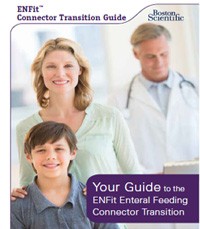
Enteral Feeding
Nutrition plays an important role in maintaining health as well as in the prevention and management of a variety of diseases. Nutritional support is therapy for people who cannot get enough nourishment by eating or drinking.¹
Enteral tube feeding is the delivery of nutrients directly into the digestive tract via a tube. The tube is usually placed into the stomach, duodenum or jejunum via either the nose, mouth or the direct percutaneous route.
It is used to feed patients who cannot obtain an adequate oral intake from food and/or oral nutritional supplements, or who cannot eat/drink safely. Enteral feeding is used commonly in patients with dysphagia – any impairment of eating, drinking and swallowing.²
Why Is a Feeding Tube Placement Needed?3
Gastrostomy feeding tubes are put in for different reasons. They may be needed for a short period of time or permanently. This procedure may be recommended for:
- People, potentially babies, with birth defects of the mouth, esophagus, or stomach (for example, esophageal atresia or tracheal esophageal fistula)
- Persons who cannot swallow correctly
- Persons who cannot take enough food by mouth to stay healthy
- Persons who often breathe in food when eating
Recent Changes in Enteral Feeding Products - ENFitTM Connectors
Important changes have been in the works to address safety issues related to tube feeding. New standards have resulted in the design of the ENFit™ Connector to help reduce the risk of a non-feeding tube device being connected to a feeding tube port.
All enteral access devices, including feeding tubes, administration sets and enteral syringes are impacted by these changes. The new connectors for nutrition formula feeding have already been implemented. Enteral-specific syringes are required to connect to the new enteral tube port for medication administration, flushing, and bolus feeding.
To learn more, visit: StayConnected.org
Feeding Tube Placement3
Endoscopic feeding tube insertion can be a simple surgery. National Institutes of Health (NIH) estimates that the stomach and abdomen of some patients may heal in 5 to 7 days. Moderate pain from the procedure can sometimes be treated with medicine.
According to NIH U.S. National Library of Medicine, the risks for surgical or endoscopic feeding tube insertion include bleeding and infection.
In some cases, feedings will start slowly with clear liquids, and increase slowly.
The patient and family or caretakers will most likely be educated on:
- How to care for the skin around the tube
- Signs and symptoms of infection
- What to do if the tube is pulled out
- Signs and symptoms of tube blockage
- How to empty the stomach through the tube (if appropriate)
- How and what to feed through the tube
- How to hide the tube under clothing
- What normal activities can be continued
This procedure is known by several names, including:
- Gastrostomy tube insertion
- G-tube insertion
- PEG tube insertion
- Stomach tube insertion
- Percutaneous endoscopic gastrostomy tube insertion.³
REFERENCES
- https://www.nlm.nih.gov/medlineplus/nutritionalsupport.html, U.S. National Library of Medicine, MedilinePlus, Updated May 19, 2015
- National Center for Biotechnology Information, National Institutes for Health, Nutrition Support for Adults: Oral Nutrition Support, Enteral Tube Feeding and Parenteral Nutrition, https://www.ncbi.nlm.nih.gov/books/NBK49253/, accessed August 2015
- U.S. National Library of Medicine, MedilinePlus, https://www.nlm.nih.gov/medlineplus/ency/article/002937.htm, Updated July 28, 2015
Patient Resources

Learn more about the transition to ENFit Connectors for Enteral Feeding products
Download Patient Guide














